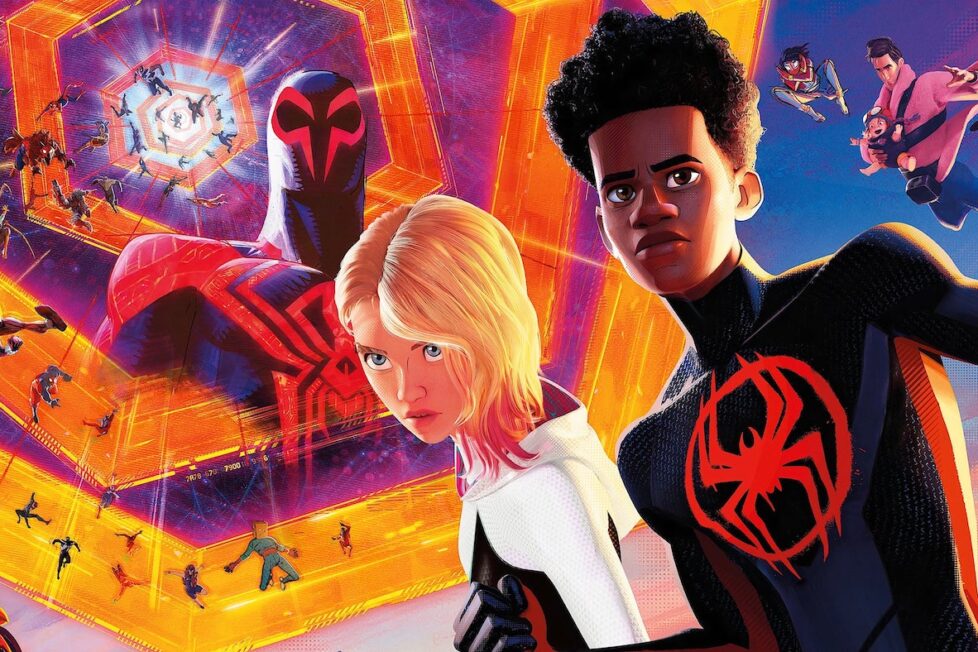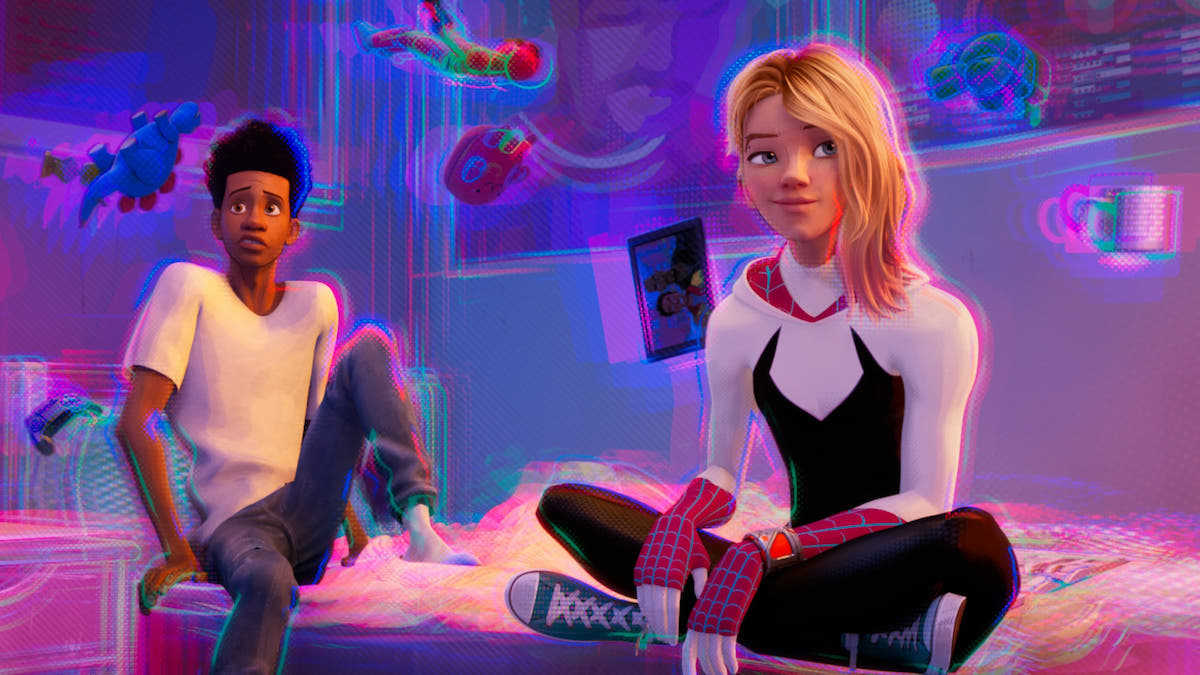SPIDER-MAN: ACROSS THE SPIDER-VERSE (2023)
Miles Morales catapults across the multiverse, where he encounters a team of Spider-People charged with protecting its existence.

Miles Morales catapults across the multiverse, where he encounters a team of Spider-People charged with protecting its existence.


Considering Sony’s unspoken admission they can’t make live-action Spider-Man films that rival the Marvel Cinematic Universe (MCU)—leading them to shift focus to spin-offs Venom (2018) and Morbius (2022)—their animated offering Spider-Man: Into the Spider-Verse (2018) is easily the best Spider-Man movie ever made and began the current trend for multiversal storytelling. A sequel was inevitable, but could Across the Spider-Verse surpass or even equal its amazing predecessor?
16 months after the events of Into the Spider-Verse, Gwen Stacy (Hailee Steinfeld) is back on Earth-65, pining for her absent friend Miles Morales (Shameik Moore) and struggling to meet the expectations of her father, a cop who doesn’t know his daughter’s actually Spider-Woman. On Earth-1610, Miles is likewise struggling to move on from Gwen and misses the other Spidey friends he made, especially middle-aged mentor Peter B. Parker (Jake Johnson), and is likewise having problems with his own parents as their hopes for his future add more pressure to his secret life as a superhero.

The separated friends are eventually drawn back together, primarily after Gwen battles a version of Vulture from a Renaissance-themed universe, which leads to her meeting futuristic Miguel O’Hara (Oscar Isaac) and pregnant Jessica Drew (Issa Rae), two Spider-People who now lead a Spider-Society sworn to fix the multiverse after it was damaged by Miles and Gwen’s encounter with Kingpin and his transdimensional collider. Miles himself also meets his self-proclaimed nemesis, The Spot (Jason Schwartzman), a scientist mutated during the aforementioned collider’s destruction, meaning his body is now riddled with black holes that act as interdimensional portals. And once Gwen reunites with Miles after joining the Spider-Society and The Spot hatches a plot to boost his own abilities using colliders from other Earths, the stage is set for another trip across various bizarre universes to save the infinite realities.
I was honestly surprised this sequel was going to tell another multiversal story, as Into the Spider-Verse felt like an adventure that just happened to involve reality-hopping and meta-comedy. Surely there would be many other problems and characters for Miles to contend with in sequels? However, perhaps the allure of playing around in this sandbox was too irresistible for the writers—Phil Lord, Christopher Miller, and David Callaham—who clearly had even wackier ideas they couldn’t fit into the first movie. Across the Spider-Verse thankfully doesn’t feel like it’s straining to squeeze the juice out of the core idea, as it’s now more about Miles exploring other universes than meeting alternate versions of himself.

As the first of a two-part story, Across the Spider-Verse suffers a little from a long 140-minute runtime (a record for a US-made animation), as the stakes don’t entirely connect until late into the third act. The first half-hour is an extensive setup for both Miles and Gwen before they reunite and we dive headfirst into more multiverse shenanigans, then the last half-hour builds to a fantastic but slightly frustrating cliffhanger. The majority of the movie is spinning its wheels before the real story gets underway, however entertainingly. It remains to be seen if the third film couldn’t possibly have been integrated into this film to tell a compete story, but I do have concerns.
However, there’s not much to complain about in terms of the characterisations and visuals. Across the Spider-Verse is every bit as wondrously animated and kinetically told as Into the Spider-Verse, with an abundance of stylish action sequences and eye-popping visuals. It may not be as fresh to the eye now, but it’s even more immersive and invigorating.

We visit plenty of amazing alternate worlds (including a Bollywood-style New York colonised by India), and each of them is drawn in a different style to make it easy to tell them apart. This simple trick is part of the reason the Spider-Verse animated movies are the best at telling multiverse stories, as live-action cousins like Doctor Strange in the Multiverse of Madness (2022) only stretch to comparatively tame ideas like cities with more plantlife than usual, whereas cartoons aren’t restricted by budget or technological limits in the same way.
The way Spider-Verse presents us with a half-dozen peculiar but plausible worlds and thousands of cleverly designed Spider-People is simply incredible stuff. We see environments inspired by artists like the futurist Sy Mead, Japanese anime, Tank Girl co-creator Jamie Hewlett, and even the décollage anarchic style of Jamie Reid… there isn’t a single frame that isn’t humming with imagination and beautiful details (like how Gwen’s world has backgrounds with trickles of paint running down them), perhaps proving definitively that animation is the natural home for comic-book adaptations. As cool as seeing hand-drawn characters being portrayed by real people often is, Spider-Verse more faithfully evokes the internal experience of reading the panels of a comic.

Nevertheless, I prefer the first movie’s more streamlined storyline over this go-for-broke sequel and its slightly repetitive second act, but it’s a fantastic companion piece that continues the core story of an awkward 15-year-old boy trying to fit in and balance the two halves of his own identity. Only now he’s up against bigger existential issues like destiny and fate. There’s even an equal amount for Gwen to do because she’s promoted to co-lead and dominates the early part of the story, while Miguel O’Hara (from the Spider-Man 2099 comics) makes for an interesting twist on Peter B. Parker’s mentor figure because he’s less likeable and doesn’t treat Miles with natural affection. Other characters involved perhaps count as minor spoilers (one voiced by Nope’s Daniel Kaluuya), but suffice it to say there’s another bunch of web-slingers with their own eccentricities and art styles to enjoy.
Across the Spider-Verse is a deeper dive into multiversal chaos which occasionally feels exhausting, but never overwhelming because there are enough quieter moments giving the characters room to breathe and understand their motivations and personal issues. This balancing act isn’t as expertly handled as Into the Spider-Verse because a sequel doesn’t require as much hand-holding now we know what to expect, but this does perhaps mean younger fans will struggle to keep up with what’s happening at times. But there’s so much colour and action it’s an enjoyable visual feast even if you lose the thread on exactly what’s going on at times.
Not without some flaws, Spider-Man: Across the Spider-Verse is only moderately inferior to the 2018 original, but it’s subjective and preferring this one doesn’t seem insane to me. It’s the Back to the Future Part II (1989) of the franchise; a bigger, bolder, weirder, and darker story that plays best for fans who can keep up with its breakneck pace. It tackles the same issues of alienation as before, if not quite as well, while also throwing in parenting and growing up. And I’m sure most issues I had can be remedied in Spider-Man: Beyond the Spider-Verse, as we’re not seeing the complete picture here…
USA | 2023 | 140 MINUTES | 2.35:1 | COLOUR | ENGLISH


directors: Joaquim Dos Santos, Kemp Powers & Justin K. Thompson.
writers: Phil Lord, Christopher Miller & David Callaham (based on Marvel Comics).
voices: Shameik Moore, Hailee Steinfeld, Brian Tyree Henry, Luna Lauren Vélez, Issa Rae, Jake Johnson, Karan Soni, Daniel Kaluuya & Oscar Isaac.
